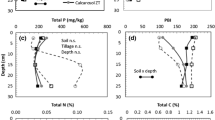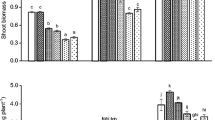Abstract
Background and aims
Crop phosphorus (P) content is controlled by P uptake from both banded P fertiliser and from P throughout the soil profile. These P supply factors are in turn controlled by soil, climatic and plant factors. The aim of this experiment was to measure the contribution of fertiliser, topsoil and subsoil P to wheat plants under wet and dry growing season conditions.
Methods
An isotopic tracer technique was used to measure P uptake from fertiliser at seven agricultural field sites under wet and dry growing season conditions. At three of these sites a dual isotopic technique was used to distinguish between wheat uptake of P from fertiliser, topsoil (0–15 cm) and subsoil (below 15 cm).
Results
The amount of P fertiliser used by wheat was in the order of 3–30% of the P applied and increased with increasing rainfall. Topsoil P was the most important P source, but when sufficient P was present in the subsoil, P fertiliser addition stimulated the use of subsoil P.
Conclusions
Most crop P uptake was from the topsoil, however P fertiliser banded below the seed increased plant P uptake and stimulated the use of subsoil P in one soil type in a decile 7 (above average rainfall) growing season.






Similar content being viewed by others
References
Adcock D, Wilhelm N, McNeill A, Armstrong R (2006) Subsoil amelioration on a sand-over-clay: crop performance and residual yield benefits. In Australian Agronomy Conference. Australian Society of Agronomy, Perth
Adcock D, McNeill AM, McDonald GK, Armstrong RD (2007) Subsoil constraints to crop production on neutral and alkaline soils in Southern Australia: a review of current knowledge and management strategies. Aust J Exp Agric 47:1245–1261
Alessi J, Power JF (1980) Effects of banded and residual fertilizer phosphorus on dryland spring wheat yield in the Northern Plains. Soil Sci Soc Am J 44:792–796
Barrow NJ (1973) Relationship between a soil’s ability to adsorb phosphate and the residual effectiveness of superphosphate. Aust J Soil Res 11:57–63
Batten GD, Wardlaw IF, Aston MJ (1986) Growth and distribution of phosphorus in wheat developed under various phosphorus and temperature regimes. Aust J Agric Res 37:459–469
Bertrand I, Holloway RE, Armstrong RD, McLaughlin MJ (2003) Chemical characteristics of phosphorus in alkaline soils from Southern Australia. Aust J Soil Res 41:61–76
Bertrand I, McLaughlin MJ, Holloway RE, Armstrong RD, McBeath TM (2006) Changes in P bioavailability induced by the application of liquid and powder sources of P, N and Zn in alkaline soils. Nutr Cycl Agroecosyst 74:27–40
Bolland MDA (1999) Decreases in Colwell bicarbonate soil test P in the years after addition of superphosphate, and the residual value of superphosphate measured using plant yield and soil test P. Nutr Cycl Agroecosyst 54:157–173
Burk L, Dalgliesh NP (2008) Estimating plant available water capacity: a methodology. CSIRO, Canberra
Cornish PS (1987) Effects of direct drilling on the phosphorus uptake and fertilizer requirements of wheat. Aust J Agric Res 38:775–790
Cornish PS (2010) A postscript to “Peak P”—an agronomist’s response to diminishing P reserves. In: Dove H (ed) Australian Agronomy Conference. Australian Society of Agronomy, Lincoln
Cornish PS, Myers LF (1977) Low pasture productivity of a sedimentary soil in relation to phosphate and water supply. Aust J Exp Agric 17:776–783
Coventry DR, Holloway RE, Cummins JA (1998) Farming fragile environments: low rainfall and difficult soils in South Australia. In: Michalk DL, Pratley JE (eds) Australian Agronomy Conference. Australian Agronomy Society, Wagga Wagga
Dang YP, Dalal RC, Routley R, Schwenke GD, Daniells I (2006) Subsoil constraints to grain production in the cropping soils of the North-Eastern region of Australia: an overview. Aust J Exp Agric 46:19–35
Dorahy CG, Rochester IJ, Blair GJ, Till AR (2008) Phosphorus use-efficiency by cotton grown in an alkaline soil as determined using 32phosphorus and 33phosphorus radio-isotopes. J Plant Nutr 31:1877–1888
Dunbabin VM, Armstrong RD, Officer SJ (2009) Identifying fertiliser management strategies to maximise nitrogen and phosphorus acquisition by wheat in two contrasting soils from Victoria. Aust J Soil Res 47:74–90
Graham RD, Ascher JS (1993) Nutritional limitations of subsoils. In: Barrow NJ (ed) Plant nutrition—from genetic engineering to field practice. Kluwer Academic Publishers, pp 739–742
Isbell RF (1997) The Australian soil classification. CSIRO Publishing, Melbourne
Kirkegaard JA, Hunt JR (2010) Increasing productivity by matching farming system management and genotype in water-limited environments. J Exp Bot 61:4129–4143
Klute A (1986) Water retention: laboratory methods. American Society of Agronomy Inc./Soil Science Society of America Inc., Madison
Kuhlmann H, Baumgartel G (1991) Potential importance of the subsoil for the P and Mg nutrition of wheat. Plant Soil 137:259–266
Lindsay WL (1979) Phosphates. In: Lindsay WL (ed) Chemical equilibria in soils. Wiley, New York, pp 162–205
Llewellyn RS, D’Emden FH (2010) How much is enough: the steep final steps to extensive no-tillage cropping in Australia. In: Dove H (ed) Australian Agronomy Conference. Australian Society of Agronomy, Lincoln
Mannikar ND, Subbiah BV (1972) Root activity and uptake of subsoil phosphorus by maize (Zea mays L.) and bersem (Trifolium alexandrinum Juslen.) as influenced by phosphorus levels in surface layer using P32 as a tracer. Indian J Agric Sci 42:592–595
Martin AE, Reeve R (1955) A rapid manometric method for determination of soil carbonate. Soil Sci 79:187–198
Mason S, McNeill A, McLaughlin M, Zhang H (2010) Prediction of wheat response to an application of phosphorus under field conditions using diffusive gradients in thin-films (DGT) and extraction methods. Plant Soil 337:243–258
Matejovic I (1997) Determination of carbon and nitrogen in samples of various soils by the dry combustion method. Commun Soil Sci Plant Anal 28:1499–1511
Mattingly GEG, Widdowson FV (1958a) Uptake of phosphorus from P32-labelled superphosphate by field crops. Part 1. Effects of simultaneous application of non-radioactive phosphorus fertilizers. Plant Soil 9:286–304
Mattingly GEG, Widdowson FV (1958b) Uptake of phosphorus from P32-labelled superphosphate by field crops. Part II. Comparison of placed and broadcast applications to barley. Plant Soil 10:161–175
McBeath TM, McLaughlin MJ, Armstrong RD, Bell M, Bolland MDA, Conyers MK, Holloway RE, Mason SD (2007) Predicting the response of wheat (triticum aestivum L.) to liquid and granular phosphorus fertilisers in Australian soils. Aust J Soil Res 45:448–458
McBeath TM, Lombi E, McLaughlin MJ, Bünemann EK (2008) Exchangeability of orthophosphate and pyrophosphate in soils: a double isotopic labelling study. Plant Soil 314:243–252
McBeath TM, Grant CD, Murray RS, Chittleborough DJ (2010) Effects of subsoil amendments on soil physical properties, crop response, and soil water quality in a dry year. Aust J Soil Res 48:140–149
McLaughlin MJ, Alston AM, Martin JK (1988) Phosphorus cycling in wheat-pasture rotations. I. The source of phosphorus taken up by wheat. Aust J Soil Res 26:323–331
McLaughlin MJ, Lancaster PA, Sale PG, Uren NC, Peverill KI (1994) Comparison of cation/anion exchange resin methods for multi-element testing of acidic soils. Plant Soil 32:229–240
McLaughlin MJ, McBeath TM, Smernik RJ, Stacey SP, Ajiboye B, Guppy C (2011) The chemical nature of P accumulation in agricultural soils—implications for fertiliser management and design: an Australian perspective. Plant Soil 344, online first 23 July 2011
Mitchell J (1957) A review of tracer studies in Saskatchwan on the utilization of phosphates by grain crops. J Soil Sci 8:73–85
Moody P, Bell M, Klepper K, Lawrence D, Pu G (2010) Implications of minimum till dryland cropping systems for diagnostic P and K soil tests. In World Congress of Soil Science, Brisbane, Australia
Nayakekorala H, Taylor HM (1990) Phosphorus uptake rates of cotton roots at different growth stages from different soil layers. Plant Soil 122:105–110
Peverill KI, Sparrow LA, Reuter DJ (eds) (1999) Methods of soil analysis—an interpretation manual. CSIRO Publishing, Collingwood
Pinkerton A, Simpson JR (1986) Interactions of surface drying and subsurface nutrients affecting plant growth on acidic soil profiles from an old pasture. Aust J Exp Agric 26:681–689
Rayment GE, Higginson FR (1992) Australian laboratory handbook of soil and water chemical methods. Inkata Press, Melbourne
Romer R, Schilling G (1986) Phosphorus requirements of the wheat plant in various stages of its life cycle. Plant Soil 91:221–229
Shierlaw J, Alston AM (1984) Effect of soil compaction on root growth and uptake of phosphorus. Plant Soil 77:15–28
Singh R, Chadha RK, Verma HN, Singh Y (1977) Response of dryland wheat to phosphorus fertilizer as influenced by profile water storage and rainfall. J Agric Sci Camb 88:591–595
Strong WM, Barry G (1980) The availability fo soil and fertilizer phosphorus to wheat and rape at different water regimes. Aust J Soil Res 18:353–362
Strong WM, Best EK, Cooper JE (1997) Phosphate fertiliser residues in wheat-growing soils of the Western Downs, Queensland. Aust J Soil Res 35:341–354
Syers JK, Johnston AE, Curtin D (2008) Efficiency of soil and fertilizer phosphorus use. Reconciling changing concepts of soil phosphorus behaviour with agronomic information. International Plant Nutrition Institute, Norcross
USDA (1982) Particle size analysis. In: Procedures for collecting soil samples and methods of analysis for soil survey. Ed. SC Service, Washington, DC
Wright AL, Hons FM, Lemon RG, McFarland ML, Nichols RL (2007) Stratification of nutrients in soil for different tillage regimes and cotton rotations. Soil Till Res 96:19–27
Zadoks JC, Chang TT, Konzak CF (1974) A decimal code for the growth stages of cereals. Weed Res 14:415–421
Zarcinas BA, Cartwright B, Spouncer LR (1987) Nitric acid digestion and multi-element analysis of plant material by inductively-coupled plasma spectrometry. Commun Soil Sci Plant Anal 18:131–146
Acknowledgements
Funding for this work was from South Australian Grains Industry Trust and Australian Research Council (LP0882492). Thanks to Minnipa Agriculture Centre and the Hunt family for providing land and watering for EP sites and to the Loller, Obst and Schober families for providing land for Mallee sites. Thanks to Bill Davoren, Anthony Whitbread, Rick Llewllyn, Glenn McDonald and Bill Bovill for collaboration in the Mallee region. We gratefully acknowledge Colin Rivers and Caroline Johnston for technical support, Sean Mason for P analyses and Erik Smolders and Yibing Ma for discussions about the topsoil-subsoil experimental design. Thanks to Rob Bramley and Sean Mason for useful comments on the manuscript.
Author information
Authors and Affiliations
Corresponding author
Additional information
Responsible Editor: Matthias Wissuwa.
Rights and permissions
About this article
Cite this article
McBeath, T.M., McLaughlin, M.J., Kirby, J.K. et al. The effect of soil water status on fertiliser, topsoil and subsoil phosphorus utilisation by wheat. Plant Soil 358, 337–348 (2012). https://doi.org/10.1007/s11104-012-1177-8
Received:
Accepted:
Published:
Issue Date:
DOI: https://doi.org/10.1007/s11104-012-1177-8




